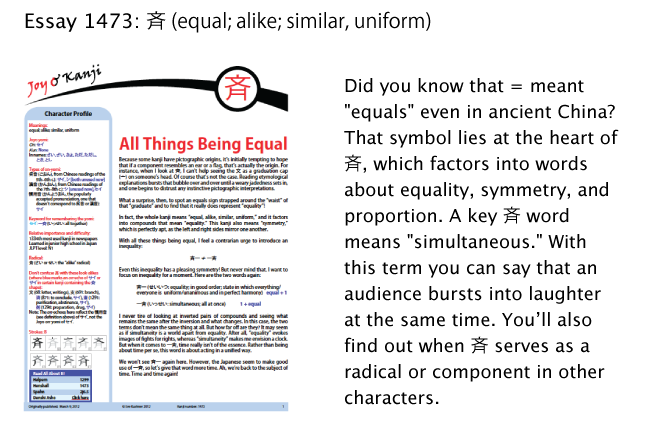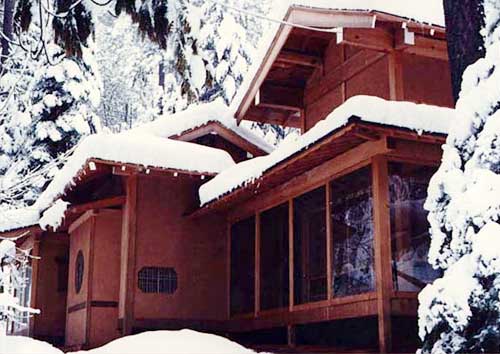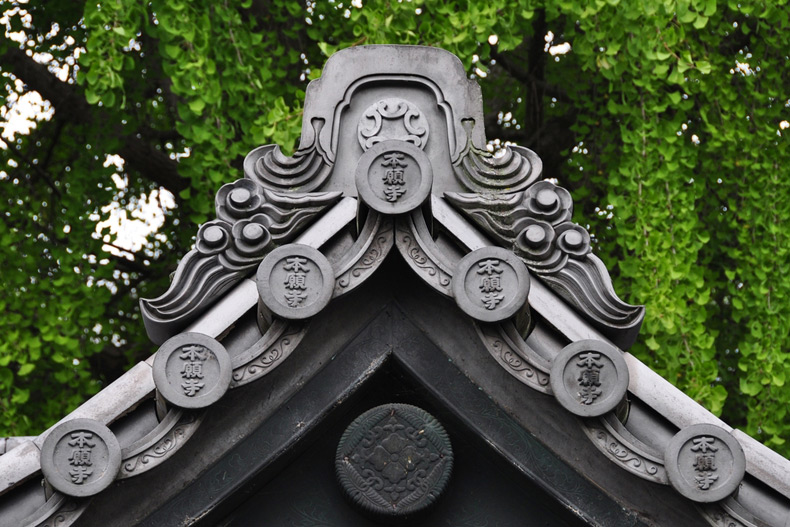Learning to See
Just about the only downside to all my kanji writing is that I have little human contact these days. I do find tremendous amounts of stimulation when I immerse myself in each character, but there's something about the unpredictability of talking to another person that can't be equaled.
Ah, the concept of an unrivaled experience reminds me of two essays:
• Essay 1513 on 双 (pair) offers a good bit of text on 無双 (むそう: peerless, unparalleled).
• Essay 1473 on 斉 (equal; alike; similar, uniform) has a lot to say about equality and just went live today. You can see a preview here:

Back to the matter of humans, my social situation finally improved this week when I did a long phone interview about a matter related to kanji. What a thrill it was!
Here's what happened. As I continued to work on essay 1388 on 匠 (craftsperson, artisan; skill), certain questions kept gnawing at me. Were all Japanese carpenters high in the social pecking order? After all, 匠 is mainly associated with woodworking and appears in several words such as 名匠 (めいしょう: master craftsperson; skillful worker) that convey an enormous amount of prestige and respect. By contrast, swinging a hammer in the United States consigns someone to the lowly realm of blue-collar worker. I couldn't stop wondering about this. Do the Japanese revere cabinetmakers, whereas we simply fail to appreciate them? Or is it that Japanese woodworking is so fine that the quality of craftsmanship elevates the worker?
As I mulled all this over, I remembered a wonderful talk I attended some years ago at a Berkeley bookstore. Len Brackett had given a slideshow and presentation of his beautiful book Building the Japanese House Today. And in the course of that evening, I learned that he had done the unthinkable.
As a young man, he had traveled to Japan as the first stop in a round-the-world journey. Awestruck by the beauty of Kyoto temples, he ended up spending the next seven years in Japan, apprenticing under a famous temple carpenter and learning how to build in the traditional Japanese way. Now, many decades later, he builds houses in California in the traditional Japanese style while making them match the realities of how people want to live these days.
Hearing about this and seeing gorgeous photos of his work (taken by his precocious photographer-daughter Aya Brackett), I was transported. Traditional Japanese architecture is one of the main things that attracted me to Japan when I first traveled there at age 13, and the rich woods, fragile shoji screens, and eye-catching roofs never fail to move me. I wrote extensively about architecture for years, and I longed to engage with traditional Japanese architecture, too, but I never saw an entry point.
By contrast, Len Brackett had done it all! He had moved to Japan, gained admittance into realms that no foreigner had ever entered, mastered the language, learned the secrets to Japanese traditional building, brought it back to California, made a viable living re-creating the architecture, and, as if all that weren't enough, written a great book about the topic. I could have been jealous, but I felt nothing but inspired. His accomplishments were 無双!

Photo Credit: Len Brackett
The house Len Brackett built for himself in the Sierra Mountains of California.
All these years later, as I struggled with the cultural context of 匠, I thought of Len Brackett, found him online, and worked up the nerve to contact him. We talked for about an hour, and I couldn't have enjoyed myself more. He did give me insight into the relative prestige of carpenters in the two countries, explaining that, compared with ordinary Japanese carpenters, temple carpenters are at the "top of the heap" in terms of skill and status. His comments about all that will go into the 匠 essay, which is quite short but seems to keep being unfinished!
For now I feel like sharing Brackett's thoughts about patterns. He told me that trying to understand traditional Japanese architecture is a lot like staring at a picture with seven cats hidden inside and attempting to locate them. With his mentor at his side, pointing out the relationships between all the elements in the design, Brackett says he could see everything clearly. Then the mentor would drift away, and so would Brackett's mental clarity. Where were those related elements again? How did everything fit together?
To him, the famous temple carpenter was nothing short of a genius (despite an education that hadn't gone past 8th grade). To me the appropriate word is "visionary." Right before I wrote my kanji book, I conceived of a book on visionary architects (one that I failed to sell), so I'm quite familiar with the concept of a visionary. As I defined it then, at least in part, a visionary sees the overarching patterns that the rest of us miss. It's as if they possess a bird's-eye view of the way everything is laid out and the relationships that hold the world together.
So it seems to be with people who can understand and create traditional Japanese architecture. As Brackett notes, the geometry at Japanese temples is mind-boggling, complex, and subtle. For example, he recalls the six-story gate they constructed for a Tokyo shrine. The gate contained 1500 rafters, each with a different curve. On site, Brackett and his colleagues dropped them into place, and they fit perfectly.

A Kyoto temple roof that has no connection to Len Brackett but that shows the complexity and beauty of traditional Japanese architecture and of kanji in one fell swoop!
I know I'll never understand the intricacies of rafters, traditional joinery, and all the rest. But I can relate to this topic on another level because I think kanji aren't so different.
On the surface, the characters seem to present nothing but chaos. They can be as intricate as the deer kanji, 鹿, and they too often look alike. Even whole words look alike. The other day I managed to mix up these two words:
厄除 (やくよけ: avoiding misfortune; lucky charm or ritual for avoiding misfortune)
危険 (きけん: danger)
Reading a Japanese-Japanese dictionary in 4-point type, I also misread the dictionary category 音符 as 意符. As luck would have it, 音符 and 意符 are antonyms, so my mind went off in entirely the wrong direction! Here's what these words mean in a kanji context (ignoring, for now, other possible definitions):
音符 (おんぷ: part of a kanji that primarily represents the pronunciation (as opposed to the meaning); phonetic component). In the Joy o' Kanji glossary under "Components, Radicals, Phonetics, and the On-Echo," this term appears as "phonetic component."
意符 (いふ: part of a kanji that primarily represents the meaning (as opposed to the pronunciation); semantic component)
Despite the way chaos seems to prevail, digging into the world of kanji yields patterns full of meaning, clarity, and beauty. Three come to mind right away:
• The structure of a character: A kanji such as 凝 (1175: to congeal) may look like a random and intimidating collection of lines. But a complex character has a structure—a radical, phonetic, and components—just as much as a building has walls, a ceiling, and a floor. You can break 凝 down to five components, each one contributing something fascinating to 凝. For instance, the lower-middle section, says Henshall, is a pictograph of an old man whose long hair (a symbol of age) trails behind him as he shakes his head from side to side, indicating that he's in doubt.
• The radical system: We can file characters under particular categories, according to whether they contain radicals such as 雨, 口, or 金. Organizing something involves embracing it to the utmost, so delving into the radical system and finding so much order underneath the surface chaos is a dream come true for a Type-A Virgo like me!
• On-echoes: In about 20 percent of Joyo kanji, there's a wonderful pattern; we see it when two or more kanji have a common phonetic component and the same on-yomi. I've dubbed this pattern the on-echo, as I explain in the next-to-last section of the glossary.
Grasping patterns and structure is truly a matter of learning to see. As The Little Prince tells us, "It is only with the heart that one can see rightly; what is essential is invisible to the eye." In a sense, then learning to see means falling in love. And when it comes to both kanji and traditional Japanese architecture, how can you not fall in love?!

Comments